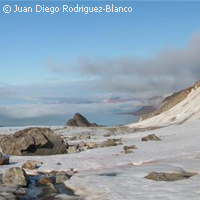Researchers in quest to find coolest forms of life on Earth
A two-woman research team is braving chilly temperatures to fuel our understanding of how life could exist on other planets in the Solar System. Their work is part of the EUROPLANET RI (European planetology network research infrastructure) project, funded under the EU's Seventh Framework Programme (FP7) to the tune of EUR 6 million. EUROPLANET RI is seeking to foster a culture of community through a range of networking activities for greater cooperation in the field of planetary sciences. Professor Liane Benning of the University of Leeds and Dr Dominique Tobler of the University of Glasgow in the UK are calling Ny-Ålesund in Norway's Arctic archipelago of Svalbard their home for two weeks (until 20 August) to explore how the area's snow and ice were first colonised by extremophiles, organisms that thrive in environments that are too extreme for the majority of our planet's organisms. Their expedition is a key component of the mega AMASE ('Arctic Mars analogue Svalbard expedition') project, that is using some of our planet's most extreme environments as a test-bed for technology that the European Space Agency (ESA) and the US-based National Aeronautics and Space Administration (NASA) will use for their 'Search for Life' missions to Mars. 'Glacial snow and ice is a good analogue for ice and frost-covered ground at the Martian poles or other icy bodies in the Solar System like Europa,' Professor Benning explained. 'Organisms that live here have evolved to thrive with very little food, large temperature fluctuations, dehydration and high levels of UV (ultraviolet) radiation. For example, snow algae make carotinoids pigments that protect them from UV radiation and cause the snow to turn bright red,' Professor Benning went on to say. 'If we can learn more about how life can form and thrive in these areas, and the survival strategies they adopt, it gives us a better chance of detecting life on other planets with similarly extreme conditions.' Past studies of microorganisms in the cryo-world targeted life found in sediment-rich subglacial ice or in melt holes on the surface. But extensive research was never carried out on signs of life found in surface ice and snow. For their study, Professor Benning and Dr Tobler will gather samples from snow fields near the Ny-Ålesund research station. They will also travel by helicopter to reach remote glacial sites for more samples. The team will filter, preserve and ship the samples back to the UK for laboratory analysis. The researchers will also assess microorganisms on site using 'life-detection techniques' in order to explore the geochemistry of inorganic samples, catalogue the biodiversity, analyse the DNA (deoxyribonucleic acid) of microorganisms, and establish live/dead cell counts. 'It's a little like CSI [Crime Scene Investigation] in the snow,' Professor Benning pointed out. 'Just like a forensics team investigating a crime scene, we have to make sure we are not detecting any contaminants we might have brought with us into the field,' she added. 'The sensitivity of our techniques is also key. If life does exist on other planets, it is likely to be present in very small amounts - just a few cells in a large area - so we need very sensitive equipment that can detect very small signals. If we don't get our experiments right on the ground, they have little chance of working elsewhere in the solar system.' Professing Benning is writing a blog on the EUROPLANET Outreach website which offers a fascinating insight into the life of a scientist on Ny-Ålesund.
Countries
Norway, United Kingdom



